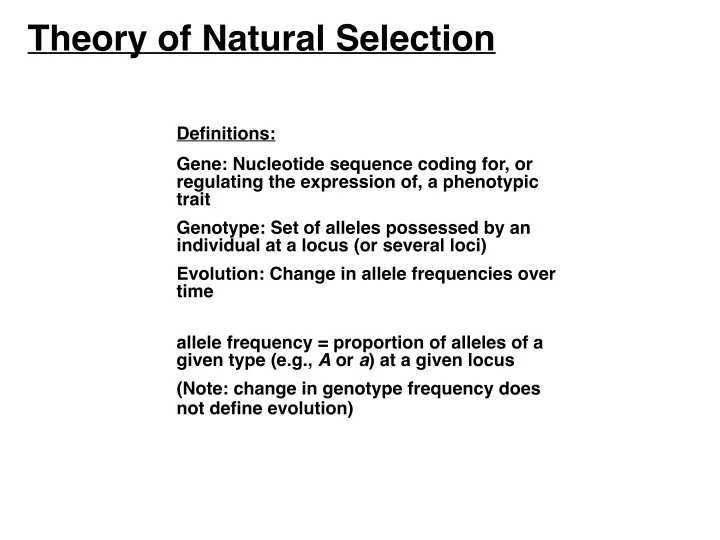

Theory of Natural Selection Definitions: Gene: Nucleotide sequence coding for, or regulating the expression of, a phenotypic trait Genotype: Set of alleles possessed by an individual at a locus (or several loci) Evolution: Change in allele frequencies over time allele frequency = proportion of alleles of a given type (e.g., A or a ) at a given locus (Note: change in genotype frequency does not define evolution)
what are the allele frequencies? AA Aa aa Genotype frequencies P(AA) = 5/8 = 0.625 -> 62.5% Q(Aa) = 2/8 = 0.25 -> 25.0% R(aa) = 1/8 = 0.125 -> 12.5% Allele frequencies p(A) = P+ 1/2Q = 0.75 -> 75% q(a) = R+ 1/2Q = 0.25 -> 25% Panaxia dominula (Arctiidae) Scarlet tiger moth
If we define evolution as change in allele frequencies over time, then…… AA Aa aa … these are the numbers we want to track over time Genotype frequencies P(AA) = 5/8 = 0.625 -> 62.5% Q(Aa) = 2/8 = 0.25 -> 25.0% R(aa) = 1/8 = 0.125 -> 12.5% Allele frequencies p(A) = P+ 1/2Q = 0.75 -> 75% q(a) = R+ 1/2Q = 0.25 -> 25%
Evolution as allele frequency change from generation n -> generation n+1 To keep things simple at first, let ’ s look first at a population where allele frequencies don ’ t change -> Hardy-Weinberg Conditions (= null model of evolution)
Hardy-Weinberg Ratios Assuming H-W conditions, for a diploid organism producing: “ A ” bearing gametes at frequency of p “ a ” bearing gametes at frequency of q chance of A + A union = p 2 chance of A + a union = pq chance of a + A union = qp chance of a + a union = q 2 total of all unions = 1 => p 2 + 2pq + q 2 = 1 Hardy-Weinberg equation
The relationship between -allele frequencies and -genotype frequencies Note again: The predictable relationship between allele and genotype frequency is true only if H-W q 2 (a,a) p 2 (A,A) conditions hold Genotype frequency What if some of the H-W conditions 2pq (A,a) are violated? - random mating - no drift - no gene flow - no mutation - no selection Allele frequency (A)
Simple model of selection -------------------------------------------------------------- Genotype Chance of Survival (= Fitness) AA, Aa 1 (= 100% survival) aa 1 - s (= 90% survival) -------------------------------------------------------------- Numerical example: - individuals of genotype “ aa ” have 10% mortality from birth to adulthood - selection coefficient s = 0.1 - AA and Aa have no mortality
Simple model of selection Change in allele frequency from time “ t ” to “ t + 1 ” : pt +1 = pt / (1 - sqt 2 ) This equation accomplishes the same as the detailed step-by-step calculations of allele frequency changes outline above
Predicted changes in allele frequency for selection against a recessive gene
Directional Selection 1. Selection Against Dominant Allele ---------------------------------------------------------------------- Genotype Chance of Survival (= relative fitness) AA 1 - s Aa 1 - s (s = selection coefficient) aa 1 ---------------------------------------------------------------------- 2. Selection Against Recessive Allele ---------------------------------------------------------------------- Genotype Chance of Survival (= relative fitness) AA 1 Aa 1 aa 1 - s ---------------------------------------------------------------------- (s = selection coefficient)
Selection against Selection against dominant allele A recessive allele a A a a A Genotype Chance of Survival Chance of Survival AA 1 - s 1 Aa 1 - s 1 aa 1 1 - s Dominant, deleterious allele A is Recessive, deleterious allele a purged from the population persists for many generations = population is rapidly fixed for a = population is slowly fixed for A
Selection against Selection against dominant allele A recessive allele a A a a A Genotype Chance of Survival Chance of Survival AA 1 - s 1 Aa 1 - s 1 aa 1 1 - s Most observed cases of selection against a deleterious trait involve recessive deleterious alleles (e.g., many human genetic diseases)
Heterozygote advantage Genotype Chance of Survival AA 1 - s Aa 1 aa 1 - t Changes of allele frequencies under heterozygote advantage 1 pequilibrium Frequency of A 0 time ----> Under heterozygote advantage, allele frequencies stabilize at some intermediate equilibrium frequencies ; => both alleles will be maintained in the population
Heterozygote advantage Maintenance of both alleles in population Equilibrium frequencies: Frequency of A: pequ = t / (s + t) Frequency of a: qequ = s / (s + t) - The equilibrium frequency is not necessarily at 50%:50% - the equilibrium frequency depends on the exact values of s and t
Sickle-Cell Anemia as a result of heterozygote advantage Global incidence of sickle-cell anemia and malaria coincides area with sickle-cell anemia area with malaria
Heterozygote advantage : Sickle-Cell Anemia ---------------------------------------------------------------------------- Chance of Estimated Genotype Phenotype Survival coefficients AA normal red blood cells 1 - s s = 0.12 AS weak anemia 1 malaria resistance SS 1 - t t = 0.86 major anemia, 80% mortality ---------------------------------------------------------------------------- Definition of Anemia : Reduction in number of red blood cells in bloodstream, resulting in generalized weakness
Sickle-Cell Anemia as a result of heterozygote advantage A and S alleles are selectively maintained because of heterozygote advantage area with sickle-cell anemia S allele is selected against area with under directional selction malaria
Frequency-dependent selection - can also maintain several alleles at a single locus -------------------------------------------------------------- Genotype Chance of Survival AA 1 - sf(AA) Aa 1 aa 1 - tf(aa) -------------------------------------------------------------- sf(AA) = selection coefficient against AA where s is dependent on frequency of AA
Examples of Frequency-Dependent Selection - Sex-Ratio Selection The rare sex has a reproductive advantage - Self-Incompatibility in Plants to avoid selfing (ensure outcrossing), pollen that has same alleles at incompatibility loci/locus is rejected => rare incompatibility alleles are selectively favored
Recommend
More recommend